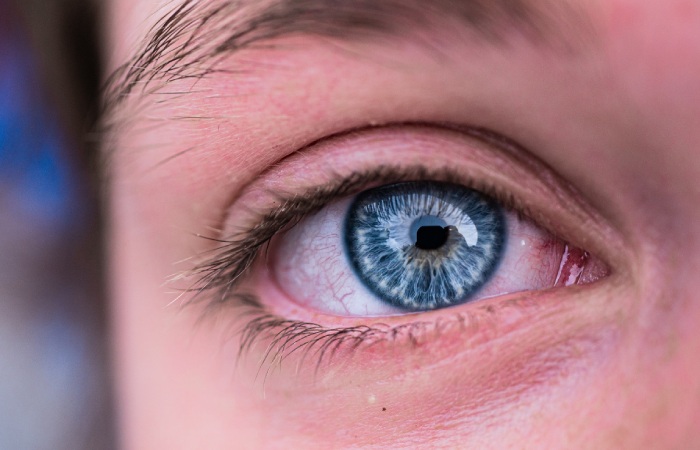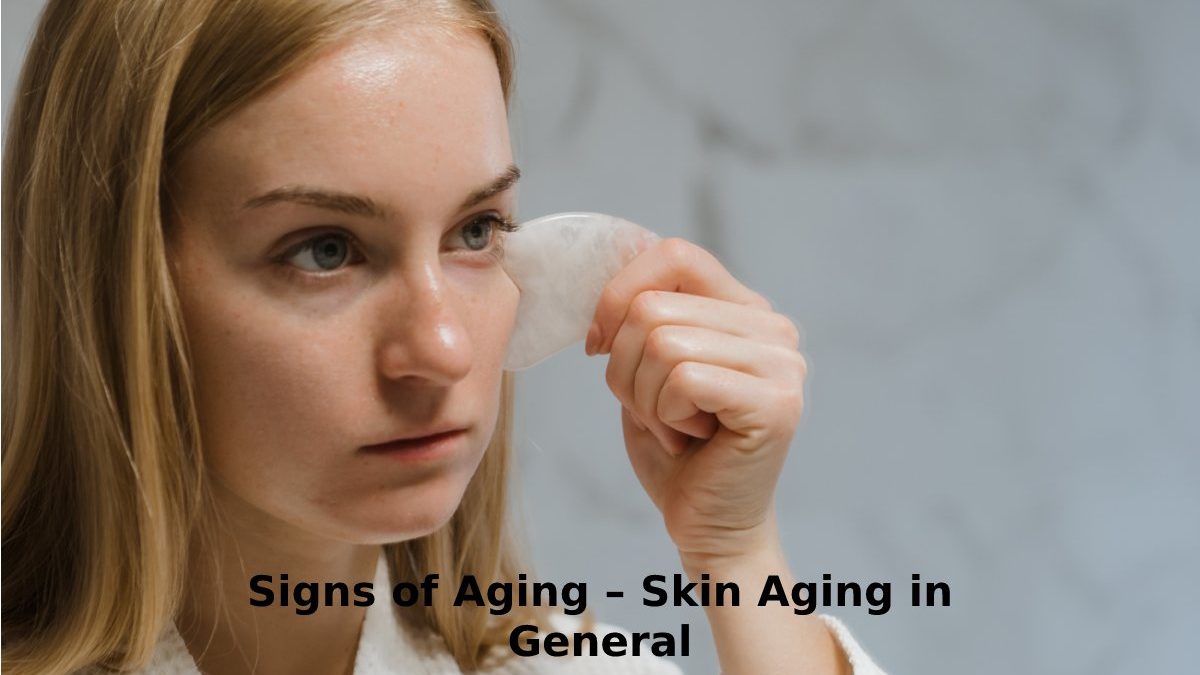From around the age of 25, the first visible signs of aging appear on the skin’s surface. First, fine lines appear, and wrinkles, loss of volume, and elasticity can be seen over time.
The skin ages for various reasons. Many of the reasons for skin ageing are entirely natural and cannot be altered. However, several factors cause the skin to age prematurely and on which it is possible to influence. A comprehensive approach to lifestyle and skincare can help reduce the visible signs of ageing and prevent premature skin ageing.
Understanding how internal and external factors affect the structure and function of the skin can help guide treatment and care options.
Table of Contents
Signs and Symptoms
There are three main manifestations of skin ageing in general. Each affects the appearance of the face in a different way.
Wrinkles

The first visible sign of ageing, starting at age 25, is fine lines and wrinkles. These appear in different areas of the face and are easy to spot. The first to appear are the fine lines. These small, shallow wrinkles tend to be most noticeable at the outer corners of the eyes, known as “frown lines” or “crow’s feet.” Next, forehead wrinkles become prominent as horizontal lines. These, due to facial expression, tend to deepen over time, while frowning causes small vertical lines between the brows.
Deeper wrinkles, recognized as “nasolabial folds,” form between the nose and mouth. These are linked to sagging skin and are often associated with loss of volume and loss of elasticity as the skin matures further.
Volume Loss
Volume loss, which is sometimes difficult to identify, is referred to as sagging skin, loss of contour, turkey neck, goosebumps, or “melted skin.” Unlike the loss of density or wrinkles, it changes the face’s overall appearance in transformative but hard to pinpoint ways. The decreased volume and sagging of facial contours associated with volume loss can give the face a negative, sad, or tired appearance. In addition, it can lead to misperceptions about a person’s mood or attitude.
Loss of Elasticity and Deep Wrinkles
Our skin loses elasticity and firmness after approximately 50 years of age; its structure weakens, and deeper wrinkles form. As skin matures, it also becomes drier, looks like “crepe paper”, and loses the radiance we associate with youthful skin.
Causes and Triggers
Skin ages due to a mixture of internal and external factors. Understanding these factors helps us care for skin as it ages, reduce the visible signs of ageing, and prevent premature skin ageing.
The signs of ageing are manifested in all layers of the skin: Changes within the layers of the skin show up on the surface as signs of aging.
Layers of the Epidermis
Slower cell turnover and less lipid production on the skin’s surface increase the likelihood that the skin will become rough and dry. In addition, as this specific layer of skin ages, it becomes more sensitive to UV radiation. As a result, the skin is less efficient at healing itself, and a decrease in immune function can lead to a rise in skin infections and slower wound healing.
Layers of the Dermis
After the age of 25, there is a decrease of 1% per year in collagen, one of the fundamental components of the skin. As a result, the skin structure is compromised, and fine lines and wrinkles are more likely. As skin matures, elasticity continues to decrease, and deeper wrinkles form. The production of Hyaluronic Acid – abundant in young skin – decreases, so skin cells are less effective at binding water and drying out. The skin also becomes weaker and prone to damage and broken capillaries. Decreased microcirculation results in a poor supply of nutrients and oxygen to the surface, leading to a diminished rosy glow typical of youthful skin.
Subdermal
Layers In the deeper layers, the most noticeable changes are in the size and number of cells that store lipids in the fatty layer. This decrease has a collateral effect on the loss of volume. And can, in turn, lead to deep wrinkles, sunken cheeks and wound healing problems.
Internal Causes of Aging
Some of the causes of facial skin ageing are unavoidable and cannot be change. Our biological age controls the structural changes in the skin and the efficiency of cellular functions. These functions decline as the years go by.
A lesser blood supply to the skin means that the delivery of nutrients and oxygen to the skin surface is obstructed. As a result, a dull skin tone predominates, and the characteristic glow of young skin disappears.
Genetics plays a crucial role in how skin ages. The ethnicity and skin kind we are born with determines how soon the signs of ageing appear on the skin’s surface. For example, sensitive skin is prone to wrinkles at a younger age, while Asian skin may be prone to rough skin tone and wrinkles appear later in life.
External Causes of Aging
The external factors that affect the speed with which the skin ages are due to a process: oxidative stress. This releases molecule called free radicals, composed of a single electron without a partner in an outer shell. Free radicals cause ageing by damaging the cellular structures of the skin.
Sun
Exposure to sunlight is the main external factor responsible for skin ageing through oxidative stress. Skin damage cause by prolong and daily exposure to UV rays is called photoaging. Which is also accountable for irregular pigment.
Pollution
Allowing the skin to be open to pollution, common in cities, can cause the release of free radicals that damage the skin. In addition, decay can worsen the effects of sun exposure by accelerating oxidative stress.
Smoking
The chemicals and nicotine in cigarettes are responsible for a significant increase in the number of free radicals present in the skin. Like pollution, these intensify the effects of sun exposure, causing oxidative stress.
Nutrition
Antioxidants are molecules that can neutralize free radicals that damage the skin and also accelerate its ageing. A diet lacking in antioxidants will do nothing to slow down the general ageing of the skin. Therefore, an essential part of caring for your skin as you age is to eat plenty of antioxidant-rich fruits and vegetables.
Insufficient Care
Skin that receives little care ages faster. Deep cleansing with products suitable for your skin type, along with the frequent application of care products that are specific to your skin problems, can have a significant influence on the skin. In addition, adequate sun protection is essential to prevent premature skin ageing.
Solutions
Skincare
Skin changes at every stage of life, and also the way it is care for should reflect its changing needs over time.
A good skincare repetitive is a vital part of a natural approach to treating the signs of ageing. Loss of volume, loss of density, wrinkles, and related processes such as age-induced dryness or sensitive, ageing skin.
If your skin is healthy, charming good care of it will stay in good condition. If not, a consistent routine can help improve the health of your skin. The skincare routine should consist of cleaning, care, and sun protection.
Cleansing
Removes makeup, dirt, and chemicals from the skin. It is essential, as chemicals present on the skin’s surface from pollution can be a trigger for oxidative stress
Care consists of nourishing and moisturizing the skin by using products appropriate for the sign of ageing that worries you the most. By focusing on the correct products and their active ingredients. Such as Hyaluronic Acid, Glycine- Saponin or Silymarin, improvements in the appearance of the skin can also made. Protecting the skin from UV rays is crucial in preventing premature skin ageing. To select the sun protection factor that you will use. You must consider your skin type and also the skin problem that concerns you.
Nutrition
Healthy food rich in fruits and vegetables will ensure the intake of antioxidants that can help limit the adverse effects of free radicals on the skin. Of course, as much variety as possible should be include. But certain foods are known to be especially strong in antioxidants. They may even have a protective effect on the skin carrots, apricots and other orange and yellow vegetables and fruits, blueberries, leafy vegetables, bell peppers, tomatoes, green beans and other legumes, and fish (especially salmon) and nuts.
Conclusion
The skin ages mainly because the existing cells no longer correctly fulfil their function. “The first effect that occurs, as a result, is the lack of production of collagen and other proteins (elastin and hyaluronic acid) that form the main structure of the skin.

